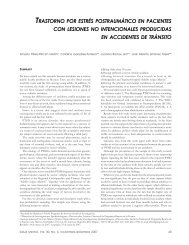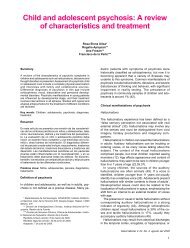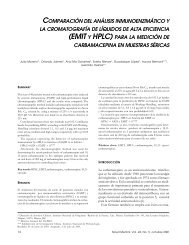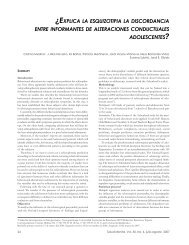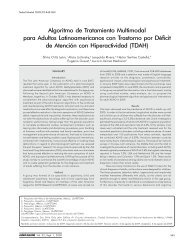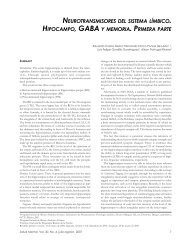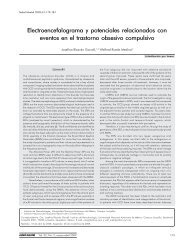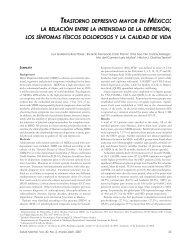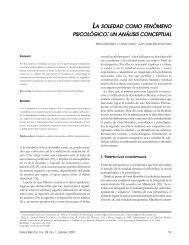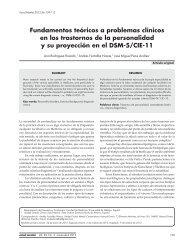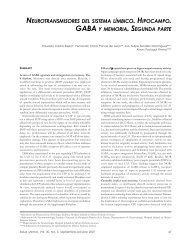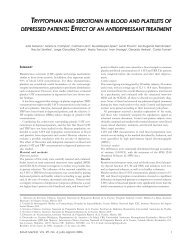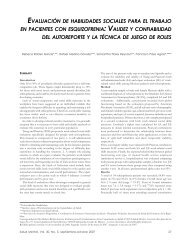SM 11.04.05 - Validacion escala Kessler.pmd - Centro de ...
SM 11.04.05 - Validacion escala Kessler.pmd - Centro de ...
SM 11.04.05 - Validacion escala Kessler.pmd - Centro de ...
Create successful ePaper yourself
Turn your PDF publications into a flip-book with our unique Google optimized e-Paper software.
Salud Mental 2011;34:323-331 Validación <strong>de</strong> la <strong>escala</strong> <strong>Kessler</strong> 10 (K-10) en la <strong>de</strong>tección <strong>de</strong> <strong>de</strong>presión y ansiedad<br />
Validación <strong>de</strong> la <strong>escala</strong> <strong>Kessler</strong> 10 (K-10) en la <strong>de</strong>tección<br />
<strong>de</strong> <strong>de</strong>presión y ansiedad en el primer nivel <strong>de</strong> atención.<br />
Propieda<strong>de</strong>s psicométricas<br />
Blanca Estela Vargas Terrez, 1 Valerio Villamil Salcedo, 1 Carmen Rodríguez Estrada, 1<br />
Jazmín Pérez Romero, 1 José Cortés Sotres 2<br />
Artículo original<br />
SUMMARY<br />
According to studies conducted in different countries, it is estimated<br />
that approximately 30% to 50% of people with mental health problems<br />
are not recognized by the general practitioner. Given this situation, it<br />
has been proposed that the practitioner at the primary care services<br />
must play a <strong>de</strong>cisive role in the early <strong>de</strong>tection of cases by establishing<br />
a <strong>de</strong>finitive diagnostic and a timely treatment. Several organizations<br />
have pointed out that one of the first actions that need to be implemented<br />
to fulfill the aims in the care of people with mental disor<strong>de</strong>rs is to prepare<br />
the first-contact doctors and to have a brief, low cost, self-applied, valid<br />
and reliable scale. The studies mention that using screening tests at the<br />
primary care level is crucial for the success of the programs. The <strong>de</strong>tection<br />
and recognition of psychiatric symptomatology rates vary <strong>de</strong>pending<br />
on the type of scale applied. The tools that have been wi<strong>de</strong>ly used are<br />
the Goldberg’s General Health Questionnaire (GHQ), Zung Self-Rating<br />
Depression Scale, Beck Depression Inventory, the Depression Symptom<br />
Checklist (DS 20), the Hopkins Symptom Checklist (SCL), the Hamilton<br />
Depression Scale, the Center for Epi<strong>de</strong>miologic Studies Depression Scale<br />
(CES-D), the Montgomery-Asberg Depression Rating Scale, the Geriatric<br />
Depression Scale (GDS), the self-administered computerized assessment<br />
(PROQSY), the criteria of the 3 rd revised edition of the Diagnostical and<br />
Statistical Manual of Mental Disor<strong>de</strong>rs (D<strong>SM</strong>-III-R), the Structured Clinical<br />
Interview for D<strong>SM</strong>-IV (SCID), and the criteria of the Symptom Driven<br />
Diagnostic System for Primary Care (SDDS-PC), among others. The<br />
preliminary results confirm the existence of a high percentage of possible<br />
psychiatric cases (46.9%), but only 4% of cases are referral. The low<br />
capability of the general practitioner at the primary care level in <strong>de</strong>tecting<br />
these pathologies has been confirmed as well. These scales have been<br />
applied in different scenarios and to different types of population.<br />
Although the dominating criteria for choosing the tool are sensitivity<br />
and specificity, some authors mention that strategies for a<strong>de</strong>quately<br />
handling cases, such as the confirmation of the diagnosis and followup<br />
of the patients, are required once the treatment has started. In this<br />
paper, we present the psychometric characteristics of the <strong>Kessler</strong> (K-10)<br />
scale in <strong>de</strong>tecting <strong>de</strong>pression and anxiety disor<strong>de</strong>rs in the primary care.<br />
Material and methods<br />
The study is a methodological process that aims to validate the <strong>Kessler</strong><br />
Psychological Distress scale (K-10). It was conducted in two health care<br />
centers of primary care level in Mexico City. The subjects were 280<br />
individuals who requested attention at the mentioned centers and to<br />
whom the K-10 test was applied after giving their informed consent.<br />
Later on, the computerized version of the International Neuropsychiatric<br />
Interview (MINI), which uses the diagnostic criteria of the D<strong>SM</strong>-IV, was<br />
applied to the subjects in or<strong>de</strong>r to confirm the diagnostics for <strong>de</strong>pression<br />
and anxiety. The MINI is a version adapted to Latin American Spanish<br />
by the National Institute of Psychiatry Ramon <strong>de</strong> la Fuente Muñiz. The<br />
diagnostic accuracy was processed following the MINI diagnoses for<br />
<strong>de</strong>pression and anxiety closely, and the scores on the scale K-10 as a<br />
predictor. The sensitivity and specificity were calculated for all possible<br />
cut points in or<strong>de</strong>r to establish the optimal cut off point. The efficiency<br />
and maximum likelihood ratios were also calculated. The area un<strong>de</strong>r<br />
the ROC curve as well as the probability quotients, positive and negative<br />
(LR+ and LR-), were also calculated.<br />
The K-10 is a brief screening tool that can be easily applied by<br />
the primary care personnel which measures the psychological distress<br />
of a person during the four weeks prior to the application. It consists of<br />
ten questions with Likert-like answers that range from 1 to 5 and are<br />
categorized in a five level ordinal scale: Always, Very Often, Sometimes,<br />
Rarely, Never; where «Never» has an assigned value of 1, and «Always»<br />
has assigned value of 5. It has a minimum score of 10 and a maximum<br />
of 50. The ranges of the instrument are four levels: low (10-15),<br />
mo<strong>de</strong>rate (16-21), high (22-29) and very high (30-50). The instrument<br />
showed an internal consistency of 0.90 and it has been used in various<br />
population studies promoted by the World Health Organization as well<br />
as government organizations in Australia, Spain, Colombia and Peru.<br />
Results<br />
Out of 280 individuals to whom the tool was applied, 78.9% (221)<br />
were female and 21.1% (59) male. These values represent the<br />
proportion of patients attending the primary care services (95%<br />
confi<strong>de</strong>nce interval=±5.4%).<br />
The mean age of women was 39 years, and the mean age of<br />
men was 41. The 70.6% of the women manifested more psychological<br />
distress than men (52.5%)[χ 2 (1)=6.05,p=0.014. No other socio<strong>de</strong>mographic<br />
variable showed significant differences.<br />
The instrument is highly precise, it can <strong>de</strong>tect up to 87% of<br />
<strong>de</strong>pression cases, and 82.4% of anxiety cases. The scale was<br />
compared with the MINI and it presented a prevalence of 26.8% and<br />
1<br />
Servicio <strong>de</strong> Psiquiatría Comunitaria. Instituto Nacional <strong>de</strong> Psiquiatría Ramón <strong>de</strong> la Fuente Muñiz.<br />
2<br />
Dirección <strong>de</strong> Enseñanza. Instituto Nacional <strong>de</strong> Psiquiatría Ramón <strong>de</strong> la Fuente Muñiz.<br />
Correspon<strong>de</strong>ncia: Dra. Blanca Estela Vargas Terrez. Servicio <strong>de</strong> Psiquiatría Comunitaria, INPRFM, Calz. México-Xochimilco 101, San Lorenzo Huipulco,<br />
14370, México DF. E.mail: vargast@imp.edu.mx<br />
Recibido primera versión: 23 <strong>de</strong> noviembre <strong>de</strong> 2010. Segunda versión: 13 <strong>de</strong> abril <strong>de</strong> 2011. Aceptado: 20 <strong>de</strong> abril <strong>de</strong> 2011.<br />
Vol. 34, No. 4, julio-agosto 2011<br />
323
Vargas Terrez et al.<br />
10.6%, respectively. Of the total of <strong>de</strong>pression cases, 26.4% also<br />
presented anxiety; these represent a co-morbidity of 5.4%. The<br />
construct validity presented one factor alone that explains the 53.4%<br />
of the total variance, this is why the scale is consi<strong>de</strong>red as onedimensional.<br />
In other words, the scale only measures the construct<br />
of the psychological distress. The internal consistency was α=0.901.<br />
Once the sensitivity and specificity for all cut off points had been<br />
<strong>de</strong>termined using the MINI as a gol<strong>de</strong>n rule, it was observed that the<br />
cut off point for maximum sensitivity and specificity correspon<strong>de</strong>d to<br />
21 for the diagnosis of <strong>de</strong>pression, and 22 for anxiety.<br />
Conclusions<br />
The K-10 is a good instrument for the <strong>de</strong>tection of <strong>de</strong>pression and<br />
anxiety cases at the primary care level which meets the criteria of validity<br />
and reliability. However, given that only one diagnosis was consi<strong>de</strong>red<br />
for all the range of anxiety disor<strong>de</strong>rs, the scale must be chosen carefully<br />
for all the other disor<strong>de</strong>rs that are not inclu<strong>de</strong>d in this paper. The use<br />
of the instrument is recommen<strong>de</strong>d for the general practitioners at the<br />
primary care level, mainly for diagnosing <strong>de</strong>pression.<br />
Various studies in which other screening instruments have been<br />
used for the <strong>de</strong>tection of <strong>de</strong>pressive disor<strong>de</strong>r at primary care point<br />
out that any screening method are useful in making the diagnosis.<br />
By using these instruments, the <strong>de</strong>pression diagnosis at primary care<br />
level increases from 10% to 47%. The latter supports the fact that the<br />
selection of a good instrument turns out to be effective in <strong>de</strong>tection,<br />
treatment and clinical outcomes of the entity.<br />
Since this recommendation is only one of the activities required<br />
in primary care level for good handling of <strong>de</strong>tected cases, it is<br />
noteworthy to mention that a comprehensive care mo<strong>de</strong>l that<br />
encompasses both the <strong>de</strong>tection as well as the pharmacological and<br />
psychosocial treatments is required.<br />
Key words: Primary care, K-10 validation, non-specific psychological<br />
distress, <strong>de</strong>pression, screening.<br />
RESUMEN<br />
De acuerdo con estudios realizados en diferentes países se estima<br />
que aproximadamente hay entre 30% a 50% <strong>de</strong> personas que presentan<br />
algún problema <strong>de</strong> salud mental que no es reconocido por el<br />
médico general. En virtud <strong>de</strong> esta situación se ha propuesto como<br />
estrategia a la atención primaria como base <strong>de</strong>l sistema <strong>de</strong> salud, lo<br />
que permitiría la <strong>de</strong>tección temprana <strong>de</strong> pacientes con algún trastorno<br />
psiquiátrico. Diferentes organismos señalan que una <strong>de</strong> las<br />
primeras acciones para cumplir con los objetivos en la atención <strong>de</strong><br />
personas con algún trastorno mental, consiste en contar con una<br />
<strong>escala</strong> breve, autoaplicable, válida y confiable y <strong>de</strong> bajo costo. En<br />
este trabajo se presentan las características psicométricas <strong>de</strong> la <strong>escala</strong><br />
<strong>Kessler</strong> (K-10) para <strong>de</strong>tectar trastornos <strong>de</strong>presivos y ansiosos.<br />
La K-10 es un instrumento <strong>de</strong> tamizaje breve y <strong>de</strong> fácil aplicación<br />
por el personal <strong>de</strong>l primer nivel <strong>de</strong> atención y ha sido utilizada en<br />
diferentes estudios a nivel poblacional. En Australia, en 1997, se<br />
aplicó la K-10 en una encuesta <strong>de</strong> salud, por medio <strong>de</strong>l Consejo<br />
Nacional <strong>de</strong> Encuestas <strong>de</strong> Salud Mental.<br />
Material y métodos<br />
Se trata <strong>de</strong> un estudio <strong>de</strong> proceso metodológico, cuyo objetivo fue la<br />
validación <strong>de</strong> la <strong>escala</strong> <strong>de</strong> malestar psicológico K-10 <strong>de</strong> <strong>Kessler</strong>. El<br />
estudio se llevó a cabo en dos <strong>Centro</strong>s <strong>de</strong> Salud <strong>de</strong>l primer nivel <strong>de</strong><br />
atención en la Ciudad <strong>de</strong> México. Los participantes fueron 280 personas<br />
que acudieron a la consulta externa <strong>de</strong> dichos centros. Se utilizaron<br />
los criterios <strong>de</strong>l D<strong>SM</strong>-IV para la confirmación <strong>de</strong>l diagnóstico <strong>de</strong> <strong>de</strong>presión<br />
y <strong>de</strong> ansiedad, por medio <strong>de</strong> la Mini International Neuropsychiatric<br />
Interview (MINI), en su versión computarizada, adaptada al español<br />
latinoamericano en el Instituto Nacional <strong>de</strong> Psiquiatría Ramón <strong>de</strong> la<br />
Fuente Muñiz. La vali<strong>de</strong>z diagnóstica se procesó utilizando los diagnósticos<br />
<strong>de</strong> la MINI para <strong>de</strong>presión y ansiedad como regla <strong>de</strong> oro y las<br />
puntuaciones obtenidas en la <strong>escala</strong> K-10 como predictor. Se calculó la<br />
sensibilidad y especificidad para todos los posibles puntos <strong>de</strong> corte con<br />
el fin <strong>de</strong> establecer el óptimo. Se calculó adicionalmente la eficiencia y<br />
las razones <strong>de</strong> máxima verosimilitud, así como el área bajo la curva<br />
ROC y los cocientes <strong>de</strong> probabilidad, positivo y negativo (LR+ y LR-).<br />
Resultados<br />
Del total <strong>de</strong> personas a quiénes se les aplicó la <strong>escala</strong>, el 78.9%<br />
(221) fueron mujeres y 21.1% (59) hombres. Estos valores representan<br />
la proporción en que los pacientes acu<strong>de</strong>n a los servicios <strong>de</strong><br />
primer nivel (IC 95%=±5.4%).<br />
El 70.6% <strong>de</strong> las mujeres presentaron mayor malestar psicológico<br />
en comparación con los hombres que representaron el 52.5%<br />
[χ 2 (1)=6.05,p=0.014]. En ninguna otra variable socio-<strong>de</strong>mográfica<br />
se presentaron diferencias significativas.<br />
El instrumento tiene una alta precisión, ya que pue<strong>de</strong> <strong>de</strong>tectar<br />
hasta el 87% <strong>de</strong> los casos <strong>de</strong> <strong>de</strong>presión y un 82.4% <strong>de</strong> los casos <strong>de</strong><br />
ansiedad. La <strong>escala</strong> se comparó con el MINI en español y presentó<br />
una prevalencia <strong>de</strong> 26.8% y 26.4%, respectivamente.<br />
Conclusiones<br />
El instrumento cumple con los criterios <strong>de</strong> vali<strong>de</strong>z y confiabilidad,<br />
por lo que se recomienda su uso por los médicos generales en el<br />
primer nivel <strong>de</strong> atención.<br />
Dado que esta recomendación sólo es una <strong>de</strong> las activida<strong>de</strong>s<br />
que se requieren en la atención primaria para un buen manejo <strong>de</strong><br />
los casos que se <strong>de</strong>tecten, es necesario señalar que se requiere <strong>de</strong><br />
un mo<strong>de</strong>lo <strong>de</strong> atención integral que incorpore tanto la <strong>de</strong>tección<br />
como el tratamiento farmacológico y psicosocial.<br />
Palabras clave: Atención primaria, validación <strong>de</strong> la <strong>escala</strong> K-10,<br />
malestar psicológico, tamizaje, <strong>de</strong>presión.<br />
INTRODUCCIÓN<br />
La alta prevalencia <strong>de</strong> morbilidad psiquiátrica en el primer<br />
nivel <strong>de</strong> atención permanece sub-diagnosticada; entre un 30%<br />
a 50% <strong>de</strong> los pacientes que se atien<strong>de</strong>n en este nivel presentan<br />
algún problema <strong>de</strong> salud mental que no es reconocido<br />
por el médico general. Los obstáculos en el diagnóstico <strong>de</strong><br />
los trastornos <strong>de</strong> salud mental generan una importante limitación<br />
para su i<strong>de</strong>ntificación y atención en los ámbitos<br />
nacional e internacional. Se han establecido diferentes estrategias<br />
para abordar este problema, sin embargo no existen<br />
suficientes evi<strong>de</strong>ncias para <strong>de</strong>terminar cuál es la mejor. 1-14<br />
Gask y Bower 4,8 proponen mo<strong>de</strong>los en los que el médico<br />
<strong>de</strong> atención primaria tiene un papel <strong>de</strong>terminante en<br />
la <strong>de</strong>tección <strong>de</strong> los casos, así como en el establecimiento <strong>de</strong><br />
un diagnóstico <strong>de</strong>finitivo y un tratamiento oportuno. Una<br />
<strong>de</strong> las primeras activida<strong>de</strong>s a <strong>de</strong>sarrollar es la capacitación<br />
<strong>de</strong>l médico para que estructure un diagnóstico confiable.<br />
324 Vol. 34, No. 4, julio-agosto 2011
Validación <strong>de</strong> la <strong>escala</strong> <strong>Kessler</strong> 10 (K-10) en la <strong>de</strong>tección <strong>de</strong> <strong>de</strong>presión y ansiedad<br />
Por lo tanto, el contar con un buen instrumento <strong>de</strong> tamizaje<br />
para la <strong>de</strong>tección <strong>de</strong> casos representa una oportunidad para<br />
que el médico general i<strong>de</strong>ntifique fácilmente a los pacientes<br />
que requieren atención, antes <strong>de</strong> referirlos a niveles especializados.<br />
9,15-21 En la literatura médica sobre intervenciones<br />
en Atención Primaria <strong>de</strong> Salud (APS), se indica que<br />
el dotar solamente <strong>de</strong> instrumentos <strong>de</strong> tamizaje a<strong>de</strong>cuados<br />
no resuelve el problema <strong>de</strong> la atención <strong>de</strong> los pacientes que<br />
presentan algún trastorno mental, y que tampoco el entrenamiento<br />
<strong>de</strong> médicos generales produce los impactos <strong>de</strong>seados<br />
cuando es la única medida instrumentada. 8,9<br />
En estudios realizados por Grupos <strong>de</strong> Trabajo Preventivos,<br />
en Estados Unidos y Canadá, señalan la importancia<br />
<strong>de</strong> la eficacia <strong>de</strong> los programas <strong>de</strong> diagnóstico y tratamiento<br />
<strong>de</strong> la <strong>de</strong>presión. 22,23 En éstos, se reporta que la utilización<br />
<strong>de</strong> cuestionarios <strong>de</strong> tamizaje en el primer nivel <strong>de</strong> atención<br />
juega un papel importante para el éxito <strong>de</strong> los programas.<br />
Dependiendo <strong>de</strong>l tipo <strong>de</strong> <strong>escala</strong>s que se apliquen, se<br />
reportan diferencias en las tasas <strong>de</strong> <strong>de</strong>tección y reconocimiento<br />
<strong>de</strong> sintomatología psiquiátrica. Los instrumentos<br />
más utilizados son los siguientes: Cuestionario General <strong>de</strong><br />
Salud <strong>de</strong> Goldberg (CGS); <strong>escala</strong> auto-aplicable <strong>de</strong> Depresión<br />
<strong>de</strong> Zung; inventario <strong>de</strong> Depresión <strong>de</strong> Beck; Depression<br />
Symptom Checklist (DS 20); <strong>escala</strong> Hopkins Symtom Check<br />
List 90 (SCL-90); <strong>escala</strong> <strong>de</strong> Depresión <strong>de</strong> Hamilton; <strong>escala</strong><br />
<strong>de</strong>l <strong>Centro</strong> <strong>de</strong> Estudios Epi<strong>de</strong>miológicos-Depresión (CES-<br />
D); <strong>escala</strong> <strong>de</strong> Depresión <strong>de</strong> Montgomery-Asberg; <strong>escala</strong> <strong>de</strong><br />
Depresión Geriátrica (GHQ); evaluación auto-administrada<br />
computarizada (PROQSY); criterios <strong>de</strong>l Manual Diagnóstico<br />
y Estadístico tercera edición revisada (D<strong>SM</strong>-III-R);<br />
entrevista clínica estructurada para D<strong>SM</strong>-IV (SCID) y los<br />
criterios diagnósticos en la Atención Primaria (SDDS). Los<br />
resultados preliminares confirman la existencia <strong>de</strong> un alto<br />
porcentaje <strong>de</strong> posibles casos psiquiátricos (46,9%) y <strong>de</strong>tecta<br />
un 4% <strong>de</strong> casos susceptibles <strong>de</strong> <strong>de</strong>rivación. Se pone también<br />
<strong>de</strong> manifiesto la baja capacidad <strong>de</strong> <strong>de</strong>tección <strong>de</strong> estas<br />
patologías por los médicos <strong>de</strong>l primer nivel. 9,24,25 Moré et<br />
al. 10 validaron la <strong>escala</strong> cuestionario <strong>de</strong> <strong>de</strong>rivación <strong>de</strong> la<br />
atención primaria a los servicios <strong>de</strong> salud mental (CD<strong>SM</strong>)<br />
hetero-administrada, multidimensional y unitaria <strong>de</strong> gravedad<br />
psiquiátrica que valora la situación <strong>de</strong>l sujeto durante<br />
el último mes, así como los criterios <strong>de</strong> <strong>de</strong>rivación a<br />
los niveles especializados.<br />
Estas <strong>escala</strong>s se han aplicado en diferentes escenarios<br />
y tipos <strong>de</strong> población. Los criterios que dominan para la<br />
selección <strong>de</strong>l instrumento son la sensibilidad y la especificidad,<br />
sin embargo algunos autores señalan que se requieren,<br />
a<strong>de</strong>más, estrategias para el manejo a<strong>de</strong>cuado <strong>de</strong> los<br />
casos, tales como la confirmación <strong>de</strong>l diagnóstico y el seguimiento<br />
<strong>de</strong> los pacientes, una vez instalado el tratamiento.<br />
24 Por otro lado, los estudios <strong>de</strong> costo-efectividad, reportan<br />
que los instrumentos <strong>de</strong> tamizaje para la <strong>de</strong>presión,<br />
así como el seguimiento <strong>de</strong> pacientes en el primer nivel,<br />
podrían dar los mismos resultados que otros servicios preventivos,<br />
tales como una mamografía en mujeres <strong>de</strong> más<br />
<strong>de</strong> 50 años para la <strong>de</strong>tección <strong>de</strong> cáncer <strong>de</strong> mama. 23,24<br />
De acuerdo con la evi<strong>de</strong>ncia <strong>de</strong> los estudios que se<br />
han realizado acerca <strong>de</strong> la precisión <strong>de</strong> los instrumentos<br />
para i<strong>de</strong>ntificar la <strong>de</strong>presión en adultos, se señala que<br />
dos preguntas muy simples acerca <strong>de</strong>l estado <strong>de</strong> ánimo y<br />
la anhedonia («¿Durante las últimas dos semanas se ha<br />
sentido triste, <strong>de</strong>primido o muy contento?», y «¿Durante<br />
las dos últimas semanas ha sentido poco interés o poco<br />
placer en las cosas que hace?»), podrían ser tan efectivas<br />
como cualquier otro instrumento formal. 22 Existen pocas<br />
evi<strong>de</strong>ncias que puedan generalizarse y recomendar algún<br />
método sobre otro; los médicos pue<strong>de</strong>n seleccionar<br />
el instrumento más consistente con las preferencias personales,<br />
el tipo <strong>de</strong> población y el ambiente <strong>de</strong> trabajo en<br />
que se aplique.<br />
En México se han validado diferentes instrumentos<br />
<strong>de</strong> tamizaje para la <strong>de</strong>tección <strong>de</strong> casos en adultos (Cuestionario<br />
General <strong>de</strong> Salud, SCL-90, CES-D, etc.), 26-31 el<br />
objetivo <strong>de</strong> la validación <strong>de</strong> estos instrumentos fue el <strong>de</strong>terminar<br />
sus características psicométricas, así como la<br />
<strong>de</strong>tección <strong>de</strong> <strong>de</strong>presión en grupos específicos, por ejemplo<br />
mujeres <strong>de</strong> zonas rurales, estudiantes universitarios,<br />
familiares <strong>de</strong> pacientes, etc. 26-31 A pesar <strong>de</strong> que algunos<br />
autores sugirieron su utilización en el primer nivel <strong>de</strong> atención,<br />
su aplicación para la <strong>de</strong>tección <strong>de</strong> <strong>de</strong>presión o ansiedad<br />
en escenarios urbanos podría resultar no tan<br />
confiable. Por lo tanto, se <strong>de</strong>cidió seleccionar otra <strong>escala</strong><br />
<strong>de</strong> fácil aplicación con el propósito <strong>de</strong> que el médico general<br />
en atención primaria pudiera i<strong>de</strong>ntificar grupos <strong>de</strong><br />
alto riesgo con trastornos mentales, y servir también como<br />
monitor <strong>de</strong> los cambios clínicos en los pacientes, a través<br />
<strong>de</strong>l tiempo (cuadro 1).<br />
La <strong>escala</strong> <strong>de</strong> malestar psicológico <strong>de</strong> <strong>Kessler</strong> (K-10) 32,33<br />
es una <strong>escala</strong> breve y <strong>de</strong> fácil aplicación por el personal <strong>de</strong>l<br />
primer nivel <strong>de</strong> atención y ha sido utilizada en diferentes<br />
estudios a nivel poblacional. En Australia, en 1997, se aplicó<br />
la K-10 en una encuesta <strong>de</strong> salud, por medio <strong>de</strong>l Consejo<br />
Nacional <strong>de</strong> Encuestas <strong>de</strong> Salud Mental (Mental Health<br />
Survey) conducido por The Australian Bureau of State. La<br />
K-10 se ha utilizado en varios estudios epi<strong>de</strong>miológicos<br />
coordinados por el profesor <strong>Kessler</strong> y sus colegas, gracias<br />
a los auspicios <strong>de</strong> la Organización Mundial <strong>de</strong> la Salud. La<br />
<strong>escala</strong> se encuentra traducida al español y se ha aplicado<br />
en España, Colombia, México y Perú, a<strong>de</strong>más <strong>de</strong> otros países<br />
<strong>de</strong> América y <strong>de</strong> Europa, sin embargo aún no están<br />
disponibles los resultados. 34<br />
En recientes investigaciones, 35 se encontró que la K-10<br />
tuvo un mejor po<strong>de</strong>r discriminatorio que el CGS-12 en la<br />
<strong>de</strong>tección <strong>de</strong> los síntomas <strong>de</strong> <strong>de</strong>presión y ansiedad <strong>de</strong>l D<strong>SM</strong>-<br />
IV. En este mismo estudio se establece la confiabilidad <strong>de</strong><br />
este instrumento <strong>de</strong> seis preguntas (K-6).<br />
Se estimó la consistencia interna <strong>de</strong> la <strong>escala</strong> K-10 mediante<br />
el cálculo <strong>de</strong>l coeficiente alfa <strong>de</strong> Cronbach, basado en<br />
Vol. 34, No. 4, julio-agosto 2011<br />
325
Vargas Terrez et al.<br />
Cuadro 1. Validación <strong>de</strong> Instrumentos en México<br />
Instrumento<br />
Población<br />
n<br />
Confiabilidad 1<br />
Cuestionario General <strong>de</strong> Salud <strong>de</strong><br />
Goldberg (CGS) (28 ítems) Romero y<br />
Medina-Mora (1987) 26<br />
Escala <strong>de</strong> Salud Personal (ESP) (10 ítems)<br />
Val<strong>de</strong>z y Sny<strong>de</strong>r (2004) 28<br />
Estudiantes universitarios <strong>de</strong> la Ciudad <strong>de</strong> México<br />
296<br />
0.84<br />
Sympton Check List (90 ítems) Cruz et al.<br />
(2005) 29<br />
Sympton Check List (90 ítems) Lara et al.<br />
(2005) 30<br />
Center For Epi<strong>de</strong>miological Studies–<br />
Depression (CES-D) (10 y 20 ítems)<br />
Bojorquez y Salgado (2009) 31<br />
Usuarias <strong>de</strong>l sector salud en clínicas <strong>de</strong> primero y<br />
segundo nivel <strong>de</strong> atención. SSA, IMSS e ISSSTE,<br />
zona norte <strong>de</strong>l país.<br />
a) Mujeres <strong>de</strong> consulta externa <strong>de</strong>l Instituto Nacional<br />
<strong>de</strong> Psiquiatría con diagnóstico <strong>de</strong> trastorno<br />
Depresivo Mayor y tratamiento anti<strong>de</strong>presivo.<br />
b) Mujeres con diagnóstico <strong>de</strong> trastorno temporomandibular,<br />
sin artritis <strong>de</strong>generativa, sin tratamiento<br />
y sin diagnóstico psiquiátrico previo.<br />
c) Madres <strong>de</strong> alumnos <strong>de</strong> una escuela secundaria.<br />
Familiares <strong>de</strong> pacientes, personal médico y paramédico<br />
y estudiantes <strong>de</strong> educación superior.<br />
Mujeres <strong>de</strong> alta marginación en tres municipios<br />
rurales en la zona Mixteca<br />
8249<br />
289<br />
118<br />
468<br />
0.85<br />
0.8<br />
0.7 y 0.66<br />
CES-D 10 0.74<br />
CES-D 20 0.84<br />
1<br />
Alfa <strong>de</strong> Crombach.<br />
las correlaciones inter-ítem y puntaje total. Los resultados<br />
obtenidos (α=0.90) indican una significativa coherencia <strong>de</strong><br />
contenido entre los ítems <strong>de</strong> la <strong>escala</strong>. Asimismo, se realizó<br />
un Análisis Factorial <strong>de</strong> Componentes Principales para estudiar<br />
la estructura subyacente <strong>de</strong> la <strong>escala</strong> K-10<br />
(KMO=0.916; Bartlett’s Test of Sphericity sig.
Validación <strong>de</strong> la <strong>escala</strong> <strong>Kessler</strong> 10 (K-10) en la <strong>de</strong>tección <strong>de</strong> <strong>de</strong>presión y ansiedad<br />
Procedimiento<br />
Previo consentimiento informado <strong>de</strong> las personas que acudían<br />
a los <strong>Centro</strong>s <strong>de</strong> Salud para solicitar consulta con su<br />
médico general, se les aplicó la <strong>escala</strong> K-10. A todas las personas<br />
que la contestaron se les aplicó la entrevista clínica<br />
computarizada MINI (Mini International Neuropsychiatric<br />
Interview Versión en español 5.0.0) para <strong>de</strong>terminar los diagnósticos<br />
<strong>de</strong> <strong>de</strong>presión y trastorno por ansiedad, según criterios<br />
<strong>de</strong>l D<strong>SM</strong>-IV.<br />
El instrumento lo aplicó personal previamente capacitado<br />
en el manejo <strong>de</strong> la K-10 y <strong>de</strong>l MINI.<br />
Análisis estadístico<br />
Para el análisis <strong>de</strong>scriptivo se calcularon las frecuencias para<br />
las variables categóricas; para las variables continuas se <strong>de</strong>terminaron<br />
las medidas <strong>de</strong> ten<strong>de</strong>ncia central y dispersión.<br />
Los análisis comparativos para las variables <strong>de</strong>mográficas<br />
se procesaron por medio <strong>de</strong> χ 2 y t <strong>de</strong> Stu<strong>de</strong>nt, según el caso.<br />
Para estas comparaciones se estableció como punto <strong>de</strong> corte<br />
el valor <strong>de</strong> 16 en la <strong>escala</strong> K-10.<br />
Las propieda<strong>de</strong>s <strong>de</strong> la <strong>escala</strong> K-10 se evaluaron por<br />
medio <strong>de</strong> análisis factorial para <strong>de</strong>terminar la vali<strong>de</strong>z <strong>de</strong><br />
constructo, y con el Coeficiente Alpha <strong>de</strong> Crombach para<br />
la consistencia interna.<br />
La vali<strong>de</strong>z diagnóstica se procesó utilizando los diagnósticos<br />
<strong>de</strong> la MINI para <strong>de</strong>presión y ansiedad como regla<br />
<strong>de</strong> oro y las puntuaciones obtenidas en la <strong>escala</strong> K-10 como<br />
predictor. Se calculó la sensibilidad y la especificidad para<br />
todos los posibles puntos <strong>de</strong> corte con el fin <strong>de</strong> establecer el<br />
punto <strong>de</strong> corte óptimo. Se calcularon adicionalmente la eficiencia<br />
y las razones <strong>de</strong> máxima verosimilitud. 39 Se calculó<br />
el área bajo la curva <strong>de</strong> la función característica <strong>de</strong> operación<br />
receptora o curva ROC. Asimismo, se estimaron los<br />
cocientes <strong>de</strong> probabilidad, positivo y negativo (LR+ y LR-).<br />
Los datos se procesaron por medio <strong>de</strong>l Programa SPSS<br />
(versión 17).<br />
RESULTADOS<br />
El total <strong>de</strong> la muestra fue <strong>de</strong> 280 personas, 221 (78.9%) mujeres<br />
y 59 (21.1%) hombres. Estos valores representan la proporción<br />
en que los pacientes acu<strong>de</strong>n a los servicios <strong>de</strong> primer<br />
nivel (IC <strong>de</strong> la muestra con 95% <strong>de</strong> confiabilidad=±5.4%).<br />
El promedio <strong>de</strong> edad en las mujeres fue <strong>de</strong> 39.17±14.2<br />
y en los hombres <strong>de</strong> 41.07±14.7. En la escolaridad predominó<br />
el nivel medio con el 23.8% y el medio superior con<br />
el 31.0%. Predominaron la personas que manifestaron estar<br />
casadas o en unión libre (34.3% y 23.9%), 64 personas<br />
manifestaron estar solteros (22.9%). Ciento diez personas<br />
Cuadro 2. Diferencia <strong>de</strong> las variables socio-<strong>de</strong>mográficas en la población participante, según los puntos<br />
<strong>de</strong> corte <strong>de</strong>l baremo <strong>Kessler</strong> K-10: mo<strong>de</strong>rado, alto y muy alto vs. bajo<br />
Malestar Psicológico K-10<br />
Mo<strong>de</strong>rado, alto y<br />
Bajo (n=93) muy alto (n=187)<br />
Variable Media D.E.* Media D.E.* Significancia<br />
Edad 37.5 13.3 40.6 14.7 F(1,277)=2.834,p=.093<br />
n % n %<br />
Sexo<br />
Masculino 28 47.5 31 52.5 χ 2 (1)=6.05,p=0.014<br />
Femenino 65 29.4 156 70.6<br />
Estado civil<br />
Soltero 19 29.7 45 70.3<br />
Casado, unión libre 62 38.0 101 62.0 χ 2 (2)=5.19,p=0.075<br />
Separado, divorciado, viudo 11 21.6 40 78.4<br />
Escolaridad<br />
Primaria 16 30.2 37 69.8<br />
Media 24 28.6 60 71.4 χ 2 (3)=6.74,p=0.081<br />
Media superior 33 32.7 68 67.3<br />
Superior 20 51.3 19 48.7<br />
Ocupación<br />
Hogar 37 33.6 73 66.4<br />
Estudiante 12 48.0 13 52.0<br />
Empleado 14 100.0 34 242.9 χ 2 (3)=2.99,p=0.393<br />
Profesionista 29 31.2 64 68.8<br />
Jubilado 1 33.3 2 66.7<br />
* Desviación estándar.<br />
Vol. 34, No. 4, julio-agosto 2011<br />
327
Vargas Terrez et al.<br />
Cuadro 3. Índices <strong>de</strong> vali<strong>de</strong>z <strong>de</strong> criterio <strong>de</strong>l K-10<br />
Dx Depresión MINI<br />
Dx Ansiedad MINI<br />
Dx K-10 Positivo Negativo Total Positivo Negativo Total<br />
Caso 59 43 102 21 64 85<br />
No caso 16 162 178 8 180 188<br />
Total 75 205 280 29 244 273<br />
IC 95% IC 95%<br />
Límite<br />
Límite<br />
Inferior Superior Inferior Superior<br />
Prevalencia <strong>de</strong> la enfermedad 26.80 21.80 32.40 10.60 7.30 15.00<br />
Eficiencia 78.90 73.60 84.60 73.60 67.50 79.70<br />
Sensibilidad 78.70 67.40 87.00 72.40 52.50 86.60<br />
Especificidad 79.00 72.70 84.30 73.80 67.70 79.10<br />
Valor predictivo<br />
Positivo 57.80 47.70 67.40 24.70 16.30 35.50<br />
Negativo 91.00 85.60 94.60 95.70 91.50 98.00<br />
Cociente <strong>de</strong> probabilida<strong>de</strong>s<br />
Positivo 3.75 2.80 5.01 2.76 2.03 3.76<br />
Negativo 0.27 0.17 0.42 0.37 0.21 0.68<br />
Área bajo curva ROC 87.00 82.00 92.00 82.40 75.00 89.70<br />
se <strong>de</strong>dican exclusivamente al hogar (39.3%), y 64 ofrecen<br />
sus servicios en alguna <strong>de</strong>pen<strong>de</strong>ncia <strong>de</strong>l gobierno (22.9%).<br />
El 66.7% (187) <strong>de</strong> las personas presentaron niveles <strong>de</strong><br />
malestar psicológico <strong>de</strong> mo<strong>de</strong>rado a alto y muy alto.<br />
El 70.6% <strong>de</strong> las mujeres presentaron mayor malestar<br />
psicológico en comparación <strong>de</strong> los hombres quienes representaron<br />
el 52.5% [χ 2 (1)=6.05,p=0.014] (cuadro 2). En ninguna<br />
otra variable socio-<strong>de</strong>mográfica se presentaron diferencias<br />
significativas.<br />
La prevalencia <strong>de</strong> casos <strong>de</strong> <strong>de</strong>presión diagnosticados<br />
con la MINI fue <strong>de</strong> 26.8% (IC 95% 21.8-32.4); la prevalencia<br />
<strong>de</strong> trastorno por ansiedad fue <strong>de</strong> 10.6% (IC 95% 7.3-15.0).<br />
Del total <strong>de</strong> casos con <strong>de</strong>presión hubo un 26.4% que presentaron<br />
ansiedad; estos representaron una co-morbilidad<br />
<strong>de</strong> 5.4%, entre el total <strong>de</strong> los casos (cuadro 3).<br />
Vali<strong>de</strong>z <strong>de</strong> constructo y consistencia interna<br />
1.0<br />
0.9<br />
0.8<br />
Sensibilidad<br />
0.7<br />
Especificidad<br />
0.6<br />
0.5<br />
0.4<br />
0.3<br />
0.2<br />
0.1<br />
0.0<br />
10 12 14 16 18 20 22 24 26 28 30 32 34 36 38 40 42 44 46 48 50<br />
Punto <strong>de</strong> corte<br />
Figura 1. Sensibilidad y Especificidad - Depresión<br />
El análisis factorial <strong>de</strong> la K-10 presentó un solo factor que<br />
explica el 53.4% <strong>de</strong> la varianza total, por lo que, <strong>de</strong> acuerdo<br />
al criterio <strong>de</strong> Armor, se consi<strong>de</strong>ra que la <strong>escala</strong> es<br />
unidimensional, 40 es <strong>de</strong>cir, sólo mi<strong>de</strong> un solo constructo:<br />
malestar psicológico. La consistencia interna resultó muy<br />
alta: α=0.901, lo que implica que los ítems que evalúan el<br />
malestar psicológico en la <strong>escala</strong> K-10 están altamente<br />
correlacionados entre sí.<br />
Vali<strong>de</strong>z diagnóstica (especificidad y sensibilidad)<br />
Una vez <strong>de</strong>terminada la sensibilidad y la especificidad para<br />
todos los posibles puntos <strong>de</strong> corte utilizando como regla<br />
<strong>de</strong> oro la MINI, se observó que el punto <strong>de</strong> corte para máxima<br />
sensibilidad y especificidad correspon<strong>de</strong> a 21 para el<br />
diagnóstico <strong>de</strong> <strong>de</strong>presión, con una sensibilidad <strong>de</strong> 78.7%<br />
(IC 95%: 67.4%-87.0%) y especificidad <strong>de</strong> 79.0% (IC 95%:<br />
Sensibilidad<br />
%<br />
100<br />
90<br />
80<br />
70<br />
60<br />
50<br />
40<br />
30<br />
20<br />
10<br />
0<br />
0% 10% 20% 30% 40% 50% 60% 70% 80% 90% 100%<br />
1. Especificidad<br />
Figura 2. Áreas bajo la curva ROC (<strong>de</strong>presión)<br />
328 Vol. 34, No. 4, julio-agosto 2011
Validación <strong>de</strong> la <strong>escala</strong> <strong>Kessler</strong> 10 (K-10) en la <strong>de</strong>tección <strong>de</strong> <strong>de</strong>presión y ansiedad<br />
Cuadro 4. Puntos <strong>de</strong> corte diferentes para <strong>de</strong>presión y ansiedad<br />
Depresión<br />
Ansiedad<br />
Punto<br />
Punto<br />
<strong>de</strong> corte Sensibilidad Especificidad <strong>de</strong> corte Sensibilidad Especificidad<br />
19 0.867 0.683 20 0.885 0.675<br />
20 0.853 0.751 21 0.808 0.703<br />
21* 0.787 0.790 22* 0.724 0.738<br />
22 0.773 0.849 23 0.655 0.758<br />
23 0.733 0.873 24 0.621 0.779<br />
*Punto <strong>de</strong> corte establecido<br />
72.7%-84.3%). El área bajo la curva ROC fue <strong>de</strong> 87.0% (IC<br />
95%: 82.0%- 92.0%) que representa un valor aceptable <strong>de</strong><br />
po<strong>de</strong>r discriminante (cuadro 3, figuras 1 y 2).<br />
El punto <strong>de</strong> corte para máxima sensibilidad y especificidad<br />
correspon<strong>de</strong> a 22 para el diagnóstico <strong>de</strong> ansiedad (cuadro<br />
4), la sensibilidad fue <strong>de</strong> 72.4% (IC 95%: 52.5%–86.6%) y<br />
la especificidad <strong>de</strong> 73.8% (IC 95%: 67.7%-79.1%). El área bajo<br />
la curva ROC fue <strong>de</strong> 82.4% (IC 95%: 75.0% - 89.7%) que representa<br />
un valor aceptable <strong>de</strong> po<strong>de</strong>r discriminante (figuras<br />
3 y 4).<br />
DISCUSIÓN<br />
En diferentes estudios se ha <strong>de</strong>mostrado la importancia <strong>de</strong><br />
contar con un instrumento <strong>de</strong> tamizaje para la <strong>de</strong>tección<br />
<strong>de</strong> trastornos psiquiátricos en el primer nivel <strong>de</strong> atención,<br />
que sea breve, <strong>de</strong> fácil aplicación y a la vez estadísticamente<br />
confiable. 9,15,22,24<br />
Las evi<strong>de</strong>ncias muestran que los instrumentos para la<br />
<strong>de</strong>tección <strong>de</strong> trastornos específicos como la <strong>de</strong>presión y la<br />
ansiedad, que no requieran <strong>de</strong> mucho tiempo para el recuento<br />
y análisis <strong>de</strong> datos, resultan más amigables para los<br />
médicos, permitiendo que integren los resultados en el proceso<br />
<strong>de</strong> toma <strong>de</strong> <strong>de</strong>cisiones para el diagnóstico y en el plan<br />
<strong>de</strong> tratamiento. 15<br />
De acuerdo con otros trabajos, nuestros resultados muestran<br />
que la K-10 es un instrumento <strong>de</strong> tamizaje potencialmente<br />
útil para la <strong>de</strong>tección <strong>de</strong> casos con <strong>de</strong>presión en la<br />
población que asiste a consulta en los <strong>Centro</strong>s <strong>de</strong>l primer<br />
nivel <strong>de</strong> Atención. Este instrumento pudo i<strong>de</strong>ntificar casos<br />
1.0<br />
0.9<br />
0.8<br />
Sensibilidad<br />
0.7<br />
Especificidad<br />
0.6<br />
0.5<br />
0.4<br />
0.3<br />
0.2<br />
0.1<br />
0.0<br />
10 12 14 16 18 20 22 24 26 28 30 32 34 36 38 40 42 44 46 48 50<br />
Punto <strong>de</strong> corte<br />
Figura 3. Sensibilidad y Especificidad - Ansiedad<br />
<strong>de</strong> <strong>de</strong>presión en un 87%, por lo que po<strong>de</strong>mos <strong>de</strong>cir que tiene<br />
una alta precisión. También pudo i<strong>de</strong>ntificar los casos positivos<br />
verda<strong>de</strong>ros en un 57.8% (VPP), así como un 91.0% <strong>de</strong><br />
casos negativos reales (VPN). Los casos con ansiedad se<br />
pudieron i<strong>de</strong>ntificar en el 82.4% es <strong>de</strong>cir, tiene una precisión<br />
mo<strong>de</strong>rada. Los casos positivos verda<strong>de</strong>ros se i<strong>de</strong>ntificaron<br />
sólo en un 24.7%, sin embargo los casos negativos verda<strong>de</strong>ros<br />
se i<strong>de</strong>ntificaron con un 95.7%. La especificidad para el<br />
diagnóstico <strong>de</strong> <strong>de</strong>presión y <strong>de</strong> trastorno <strong>de</strong> ansiedad fue <strong>de</strong><br />
79% y 73.8% respectivamente. Estos resultados coinci<strong>de</strong>n con<br />
lo reportado por Cairney, 20 en población general.<br />
La eficiencia <strong>de</strong> la K-10 fue <strong>de</strong> casi el 80% (78.9%)<br />
para la <strong>de</strong>presión y <strong>de</strong> 73.6% para la ansiedad, por lo que<br />
se <strong>de</strong>muestra nuevamente que el valor predictivo global<br />
<strong>de</strong> la prueba, es <strong>de</strong>cir el porcentaje con el que la prueba<br />
diagnostica correctamente, es más consistente para el trastorno<br />
<strong>de</strong>presivo que para el <strong>de</strong> ansiedad. Por otro lado,<br />
<strong>de</strong> acuerdo con la razón <strong>de</strong> verosimilitud positiva, la K-<br />
10 tiene una probabilidad 3.75 veces mayor <strong>de</strong> ser positivo<br />
entre los enfermos que entre los no enfermos. En el<br />
caso <strong>de</strong>l trastorno <strong>de</strong> ansiedad su comportamiento es <strong>de</strong><br />
2.8. La razón <strong>de</strong> verosimilitud negativa fue <strong>de</strong> 0.27 y 0.37,<br />
respectivamente, lo que nos indica que la probabilidad<br />
<strong>de</strong> que la prueba resulte negativa entre los enfermos más<br />
que entre los no enfermos es muy baja. En ambas situaciones<br />
los resultados nos indican que la K-10 es un buen<br />
Sensibilidad<br />
%<br />
100<br />
90<br />
80<br />
70<br />
60<br />
50<br />
40<br />
30<br />
20<br />
10<br />
0<br />
0% 10% 20% 30% 40% 50% 60% 70% 80% 90% 100%<br />
1. Especificidad<br />
Figura 4. Áreas bajo la curva ROC (ansiedad)<br />
Vol. 34, No. 4, julio-agosto 2011<br />
329
Vargas Terrez et al.<br />
instrumento tanto para la <strong>de</strong>tección <strong>de</strong> enfermos como<br />
para la <strong>de</strong> los no enfermos.<br />
Estos hallazgos coinci<strong>de</strong>n con otros estudios <strong>de</strong> validación<br />
<strong>de</strong> la K-10 que se han llevado a cabo a nivel internacional.<br />
20,33,35,37,41,42<br />
Consi<strong>de</strong>ramos que la K-10 es un buen instrumento para<br />
la <strong>de</strong>tección <strong>de</strong> casos <strong>de</strong> <strong>de</strong>presión y ansiedad en el primer<br />
nivel <strong>de</strong> atención, sin embargo, dado que sólo se consi<strong>de</strong>ró<br />
un solo diagnóstico <strong>de</strong> toda la gama <strong>de</strong> trastornos <strong>de</strong> ansiedad,<br />
se <strong>de</strong>be <strong>de</strong> tomar con precaución elegirla para todos<br />
los <strong>de</strong>más trastornos que no están incluidos en este trabajo.<br />
Existen estudios en don<strong>de</strong> se han utilizado diversos instrumentos<br />
<strong>de</strong> tamizaje para la <strong>de</strong>tección <strong>de</strong>l trastorno <strong>de</strong>presivo<br />
en la atención primaria. Éstos señalan que <strong>de</strong> acuerdo<br />
con los resultados <strong>de</strong> revisiones sistemáticas y meta-análisis<br />
que se han llevado a cabo, cualquier método <strong>de</strong> tamizaje<br />
es útil para efectuar el diagnóstico, ya que el uso <strong>de</strong> estos<br />
instrumentos lo mejora entre un 10% y un 47% en el primer<br />
nivel. Lo anterior refuerza la opinión <strong>de</strong> que la selección <strong>de</strong><br />
un buen instrumento resulta eficaz para la <strong>de</strong>tección, el tratamiento<br />
y el <strong>de</strong>senlace clínico <strong>de</strong> la <strong>de</strong>presión. 15,24,25<br />
En este estudio se <strong>de</strong>muestra que la versión en español<br />
<strong>de</strong> la <strong>escala</strong> K-10 es eficaz para la <strong>de</strong>tección <strong>de</strong> casos<br />
<strong>de</strong> <strong>de</strong>presión, a<strong>de</strong>más <strong>de</strong> que es una <strong>escala</strong> breve, <strong>de</strong> fácil<br />
aplicación por el médico general o algún otro personal <strong>de</strong>l<br />
primer nivel <strong>de</strong> atención. Como se pudo observar, tanto la<br />
sensibilidad como la especificidad son muy parecidas, siendo<br />
su eficiencia global a<strong>de</strong>cuada para nuestra población<br />
(78.9%). El punto <strong>de</strong> corte indicado para la <strong>de</strong>presión es<br />
<strong>de</strong> 21, lo que coinci<strong>de</strong> con los puntos <strong>de</strong> corte propuestos<br />
por <strong>Kessler</strong> et al. 32 . Con respecto a la <strong>de</strong>tección <strong>de</strong> los trastornos<br />
<strong>de</strong> ansiedad, consi<strong>de</strong>ramos que la eficiencia es débil<br />
(73.6%), sin embargo resulta interesante que a pesar <strong>de</strong><br />
la baja eficiencia pue<strong>de</strong> <strong>de</strong>tectar casi el 25% <strong>de</strong> los casos<br />
positivos.<br />
Consi<strong>de</strong>ramos por tanto que este instrumento pue<strong>de</strong><br />
utilizarse en el primer nivel <strong>de</strong> atención, señalando que en<br />
los casos cuyo punto <strong>de</strong> corte sea <strong>de</strong> 21 y más, se <strong>de</strong>be establecer<br />
un diagnóstico <strong>de</strong>finitivo con la posibilidad <strong>de</strong> que<br />
el diagnóstico sea a<strong>de</strong>cuado en casi un 88% (87.3).<br />
Si bien un instrumento <strong>de</strong> tamizaje permite incrementar<br />
el diagnóstico <strong>de</strong> dos <strong>de</strong> los trastornos psiquiátricos<br />
más frecuentes en la población general, por sí solo no es<br />
suficiente para proporcionar un tratamiento y seguimiento<br />
a<strong>de</strong>cuados <strong>de</strong> las personas con estos trastornos. En diferentes<br />
estudios se reporta que hay un impacto importante<br />
en el diagnóstico <strong>de</strong> la <strong>de</strong>presión por el uso <strong>de</strong> instrumentos<br />
<strong>de</strong> tamizaje que utilizan los médicos generales,<br />
sin embargo existen otros en dón<strong>de</strong> esto no se comprueba.<br />
9,43 A pesar <strong>de</strong> las controversias acerca <strong>de</strong> la importancia<br />
que tienen tales instrumentos, la estrategia <strong>de</strong> utilizarlos<br />
permitiría la i<strong>de</strong>ntificación <strong>de</strong> los pacientes que efectivamente<br />
requieren atención, sin que esto represente un alto<br />
costo. 43<br />
Dentro <strong>de</strong> los mo<strong>de</strong>los <strong>de</strong> atención que se proponen, se<br />
establece una atención integral <strong>de</strong> los pacientes a quiénes se<br />
les <strong>de</strong>tectan puntuaciones altas tanto <strong>de</strong> <strong>de</strong>presión como <strong>de</strong><br />
ansiedad. Éstos requieren <strong>de</strong> la estructuración <strong>de</strong> tratamientos<br />
en los que participe un grupo <strong>de</strong> profesionales <strong>de</strong>l primer<br />
nivel <strong>de</strong> atención, así como la intervención <strong>de</strong>l especialista<br />
en psiquiatría que trabaje <strong>de</strong> manera coordinada con el<br />
equipo. Se insiste en que la utilización <strong>de</strong> instrumentos no<br />
produce los impactos <strong>de</strong>seados cuando es la única medida<br />
instrumentada. 9 Por lo tanto, se propone un tipo <strong>de</strong> trabajo<br />
colaborativo en don<strong>de</strong> el psiquiatra o profesional especializado<br />
oriente el diagnóstico y el tratamiento farmacológico y<br />
en don<strong>de</strong> el médico general sea el responsable <strong>de</strong>l seguimiento<br />
<strong>de</strong> los pacientes. Los otros miembros <strong>de</strong>l equipo (enfermeras,<br />
trabajadores sociales, psicólogos, etc.) trabajan <strong>de</strong><br />
manera conjunta para el apoyo psicosocial. 16<br />
La USPSTF 22 señaló, por su lado, que no hay suficientes<br />
evi<strong>de</strong>ncias para recomendar el uso <strong>de</strong> instrumentos <strong>de</strong><br />
tamizaje <strong>de</strong> manera sistemática para el primer nivel <strong>de</strong> atención.<br />
Se requiere también que los Servicios <strong>de</strong> Salud <strong>de</strong>sarrollen<br />
un plan <strong>de</strong> atención integral, con estructura y <strong>de</strong><br />
buena calidad, para el tratamiento <strong>de</strong> la <strong>de</strong>presión en el<br />
primer nivel <strong>de</strong> atención. Esto permitiría obtener mejores<br />
resultados y elevar los beneficios. La <strong>de</strong>presión es un problema<br />
que arroja una alta carga en salud, a<strong>de</strong>más <strong>de</strong> que<br />
está asociada a otras enfermeda<strong>de</strong>s crónicas por lo que requiere<br />
que los sistemas <strong>de</strong> salud establezcan políticas en<br />
las que este problema sea un programa prioritario y se <strong>de</strong>stinen<br />
recursos para su <strong>de</strong>sarrollo. 44<br />
AGRADECIMIENT<br />
GRADECIMIENTOS<br />
Este trabajo forma parte <strong>de</strong> una investigación más amplia * cuyo objetivo<br />
general es la estructuración <strong>de</strong> un mo<strong>de</strong>lo <strong>de</strong> atención en salud<br />
mental para el primer nivel <strong>de</strong> atención, y uno <strong>de</strong> los objetivos<br />
específicos es la validación <strong>de</strong> un instrumento breve que permita<br />
su aplicación por el médico general. El estudio fue aprobado por el<br />
Comité <strong>de</strong> Ética en Investigación <strong>de</strong>l Instituto Nacional <strong>de</strong> Psiquiatría<br />
Ramón <strong>de</strong> la Fuente.<br />
Agra<strong>de</strong>cemos a los resi<strong>de</strong>ntes, doctores Nadia Morales<br />
Gordillo, Víctor Hugo Obregón García, José Antonio Jasso Molina e<br />
Iván Dersu Vargas Cardoso; al psicólogo Gerardo Obregón<br />
Hernán<strong>de</strong>z, y a los alumnos Alejandra Solís Flores y Eduardo<br />
Carballar Alvarado, por su colaboración <strong>de</strong>sinteresada en el <strong>de</strong>sarrollo<br />
<strong>de</strong> este trabajo.<br />
REFERENCIAS<br />
1. Araya R, Rojas G, Fritsch R. Treating <strong>de</strong>pression in primary care in low<br />
income women in Santiago, Chile: a randomized controlled trial. Lancet<br />
2003;361:995-1000.<br />
* Vargas B, Villamil V, Rodríguez C, Pérez J. Mo<strong>de</strong>lo <strong>de</strong> intervención en salud<br />
mental en el primer nivel <strong>de</strong> atención. Proyecto <strong>de</strong> Investigación # 2392,<br />
autorizado por el Comité <strong>de</strong> Investigación <strong>de</strong>l Instituto Nacional <strong>de</strong> Psiquiatría<br />
Ramón <strong>de</strong> la Fuente, 2009.<br />
330 Vol. 34, No. 4, julio-agosto 2011
Validación <strong>de</strong> la <strong>escala</strong> <strong>Kessler</strong> 10 (K-10) en la <strong>de</strong>tección <strong>de</strong> <strong>de</strong>presión y ansiedad<br />
2. Borges G, Wang PS, Medina-Mora ME, Lara C et al. Delay of first treatment<br />
of mental and substance use disor<strong>de</strong>rs in Mexico. Am J Public<br />
Health 2007;97(9):1638-1643.<br />
3. Bower P, Gask L. The changing nature of consultation-liaison in primary<br />
care: bridging the gap between research and practice. Gen Hosp<br />
Psychiatry 2002;24:63-70.<br />
4. Bower P, Gilbody S. Managing common mental health disor<strong>de</strong>rs in primary<br />
care: conceptual mo<strong>de</strong>ls and evi<strong>de</strong>nce base. BMJ 2005;330:839-842.<br />
5. Bi<strong>de</strong>rman A, Yeheskel A, Tan<strong>de</strong>ter H, Umansky R. Advantages of the<br />
psychiatric liaison-attachment scheme in a family medicine clinic. Isr J<br />
Psychiatry Relat Sci 1999;36:115–121.<br />
6. Caraveo J, Medina-Mora ME, Tapia R, Rascón ML et al. Trastornos psiquiátricos<br />
en niños <strong>de</strong> la República Mexicana. Resultados <strong>de</strong> una encuesta<br />
<strong>de</strong> hogares. INPRFM (ed.). Anales. Reseña <strong>de</strong> la VII Reunión <strong>de</strong><br />
Investigación; 1992; pp. 56-62.<br />
7. Fava G, Park S, Dubovsky S. <strong>Centro</strong>s <strong>de</strong> salud mental: un nuevo mo<strong>de</strong>lo.<br />
World Psychiatry (ed. Español) 2008;6(3):49-53.<br />
8. Gask L, Sibbald B, Creed F. Evaluating mo<strong>de</strong>ls of working at the interface<br />
between mental health services and primary care. British Journal of<br />
Psychiatry 1997;170:6-11.<br />
9. Gilbody S, House A, Sheldon T. Routinely administered questionnaires<br />
for <strong>de</strong>pression and anxiety: a systematic review. British Medical J<br />
2001;322:406-409.<br />
10. Moré M, Jiménez M, Muñoz P, Muñoz <strong>de</strong> Morales A et al. Estudio preliminar<br />
dirigido a la construcción <strong>de</strong> un cuestionario <strong>de</strong> <strong>de</strong>rivación <strong>de</strong> la<br />
atención primaria a los servicios <strong>de</strong> salud mental. Actas Esp Psiquiatría<br />
2008;36(4):2010-2217.<br />
11. Organización Mundial <strong>de</strong> la Salud. Prevención <strong>de</strong> los trastornos mentales.<br />
Intervenciones efectivas y opiniones políticas. Génova: Reporte; 2004.<br />
12. Ortiz A, González R, Rodríguez F. La <strong>de</strong>rivación a salud mental <strong>de</strong> pacientes<br />
sin un trastorno psíquico diagnosticable. Atención Primaria<br />
2006;38(10):563-569.<br />
13. Sartorius N. Mental health and primary health Care. Mental Health Family<br />
Medicine 2008;5:75-77.<br />
14. World Health Organization y World Family Doctors Family Carrying<br />
for People (WONCA). Integrating mental health into primary are. Génova:<br />
A Global Perspective; 2008.<br />
15. Gilbody S. Sheldon T. House A. Screening and case-finding instruments<br />
for <strong>de</strong>pression: a meta-analysis. Canadian Medical Association Licensors<br />
2008;178(8):997-1003.<br />
16. King V, Stoller K, Hayes M. A multicenter randomized evaluation of<br />
methadone medical maintenance. Drug Alcohol Depen<strong>de</strong>nce<br />
2002;65:137-148.<br />
17. Bradford F, Chaney E, Rubenstein L, Bonner L et al. Developing effective<br />
collaboration between primary care and mental health provi<strong>de</strong>rs.<br />
Primary Care Companion J Clinical Psychiatry 2006;8(1):12-16.<br />
18. Aragonés E. Desacuerdos diagnósticos entre médicos generales y psiquíatras.<br />
Atención Primaria 2008;40(12):644.<br />
19. Bo<strong>de</strong>nheimer T, Yoshio B. The team let mo<strong>de</strong>l of primary care. Annals<br />
Family Medicine 2007;5(5):457-461.<br />
20. Cairney J, Scott V, Wa<strong>de</strong> T, Kurdyak P et al. Evaluation of 2 measures of<br />
psychological distress as screeners for <strong>de</strong>pression in the general population.<br />
Canadian J Psychiatry 2007;52:111-120.<br />
21. Carr VJ, Faehrmann C, Lewin TJ, Walton JM et al. Determining the<br />
effect the consultation-liaison psychiatry in primary care has on family<br />
physicians’ psychiatric knowledge and practice. Psychosomatics<br />
1997; 38:217-229.<br />
22. U.S. Preventive services task force recommendation statement screening<br />
for <strong>de</strong>pression in adults. Annals Internal Medicine 2009;151:784-792.<br />
23. MacMillan H, Petterson C, Wathen C. Screening for <strong>de</strong>pression in primary<br />
care: recommendation statement from the Canadian task force on<br />
preventive health care. Canadian Medical Association Licensors<br />
2005;172(1):33-35.<br />
24. Pignone P, Gaynes B, Rushton J, Burchell C et al. Screening for <strong>de</strong>pression<br />
in adults: A summary of the Evi<strong>de</strong>nce for the U.S. preventive services<br />
task force. Annals Internal Medicine 2002;136(10):765-776.<br />
25. Bedamgarav E, Weingarten S, Heninig J, Knigth K et al. Eficacia <strong>de</strong> los<br />
programas diagnósticos y terapéuticos <strong>de</strong> la <strong>de</strong>presión: una revisión sistemática.<br />
Am J Psychiatry 2002;7:127-137.<br />
26. Romero M, Medina-Mora ME. Vali<strong>de</strong>z <strong>de</strong> una versión <strong>de</strong>l cuestionario<br />
general <strong>de</strong> salud, para <strong>de</strong>tectar psicopatología en estudiantes universitarios.<br />
Salud Mental 1987;10(3):90-97.<br />
27. Gómez M, Caraveo A. Instrumentos <strong>de</strong> diagnóstico en la epi<strong>de</strong>miología<br />
psiquiátrica. Salud Mental 1996;19(supl):60-64.<br />
28. Val<strong>de</strong>z R, Salgado N. Escala breve para i<strong>de</strong>ntificar malestar emocional<br />
en la práctica médica <strong>de</strong> primer nivel: características psicométricas. Salud<br />
Mental 2004; 27(4):55-62.<br />
29. Cruz C, López L, Blas C, González L et al. Datos sobre la vali<strong>de</strong>z y confiabilidad<br />
<strong>de</strong> la Symptom Check List 90(SCL90) en una muestra <strong>de</strong> sujetos<br />
mexicanos. Salud Mental 2005;28(1):72-81.<br />
30. Lara C, Espinosa I, Cár<strong>de</strong>nas M, Fócil M et al. Confiabilidad y vali<strong>de</strong>z<br />
<strong>de</strong> la SCL-90 en la evaluación <strong>de</strong> psicopatología en mujeres. Salud Mental<br />
2005;28(3):42-50.<br />
31. Bojorquez L, Salgado N. Características psicométricas <strong>de</strong> la Escala Center<br />
for Epi<strong>de</strong>miological Studies-<strong>de</strong>pression (CES-D), versiones <strong>de</strong> 20 y<br />
10 reactivos, en mujeres <strong>de</strong> una zona rural mexicana. Salud Mental<br />
2009;32(4):299-307.<br />
32. <strong>Kessler</strong> R, McGonagle K, Zhao S, Nelson Cet al. Lifetime and 12-month<br />
prevalence of D<strong>SM</strong> III- R psychiatric disor<strong>de</strong>rs in the United States: results<br />
from the national Co morbidity Survery. Archives General Psychiatry<br />
1994;51:8-19.<br />
33. <strong>Kessler</strong> R, Andrews G, Cople L, Hiripi E et al. Short screening scales to<br />
monitor population prevalence and trends in non-specific psychological<br />
distress. Psychological Medicine 2002;32:959-976.<br />
34. Australian Bureau of Statistics. Information Paper: Use of the <strong>Kessler</strong> Psychological<br />
Distress Scale in ABS Health Surveys. Australia: 2001; p. 14.<br />
35. Furukawa T, <strong>Kessler</strong> R, Sla<strong>de</strong> T, Andrews G. The performance of the K6<br />
and K10 screening scales for psychological distress in the Australian<br />
National Survey of Mental Health and Well-Being. Psychological Medicine<br />
2003;33:357-362.<br />
36. Brenlla ME. Condiciones sociales y características psicológicas: Un estudio<br />
en sectores urbanos <strong>de</strong> la Argentina. Serie Monitoreo <strong>de</strong> la Deuda<br />
Social. Universidad Católica <strong>de</strong> Argentina. Documento 3; 2005; p. 38.<br />
www.scribd.com/doc/8319346.<br />
37. Baillie A. Predictive gen<strong>de</strong>r and education bias in <strong>Kessler</strong>´s psychological<br />
distress Scale (K10). Soc Psychiatr Epi<strong>de</strong>miol 2005;40:743-748.<br />
38. Heinze G, Sheehan D, Cortés J. Mini International Neuropsychiatric Interview<br />
(MINI): Spanish version (South and Central America) 5.0.0.<br />
D<strong>SM</strong>-IV. México, DF: Instituto Nacional <strong>de</strong> Psiquiatría; 2000.<br />
39. Fernán<strong>de</strong>z P, Díaz P. Unidad <strong>de</strong> Epi<strong>de</strong>miología Clínica y Bioestadística.<br />
Complejo Hospitalario-Universitario Juan Canalejo. A Coruña, España:<br />
Cad Aten Primaria; 2003; 10: 120-124. www.fisterra.com/.../<br />
pruebas_diagnosticas/pruebas_diagnosticas2.pdf. Revisado el 17 <strong>de</strong> agosto<br />
2010.<br />
40. Morales P. Medición <strong>de</strong> actitu<strong>de</strong>s en psicología y educación. Tercera<br />
edición revisada. Madrid: Universidad Pontificia Comillas; 2006.<br />
41. <strong>Kessler</strong> R, Barker P, Colpe L, Epstein J et al. Screening for serious mental<br />
illness in the general population. Arch Gen psychiatry 2003;60:184-189.<br />
42. Spies G, Stein D, Roos A, Faure S et al. Validity of the <strong>Kessler</strong> 10 (K-10)<br />
in <strong>de</strong>tecting S<strong>SM</strong>-IV <strong>de</strong>fined moon and anxiety disor<strong>de</strong>rs among pregnant<br />
women. Arch Women Ment Health 2009;12:69-74.<br />
43. Valestein M, San<strong>de</strong>ep V, Zeber J, Boehm K et al. The cost-utility of screening<br />
for Depression in Primary Care. Ann Intern Med 2001;134:345-360.<br />
44. Simon G, Fleck M, Lucas R, Bushnell D. Prevalence and predictors of<br />
<strong>de</strong>pression treatment in an international primary care study. Am J<br />
Psychiatry 2004;161:169.<br />
Artículo sin conflicto <strong>de</strong> intereses<br />
Vol. 34, No. 4, julio-agosto 2011<br />
331



